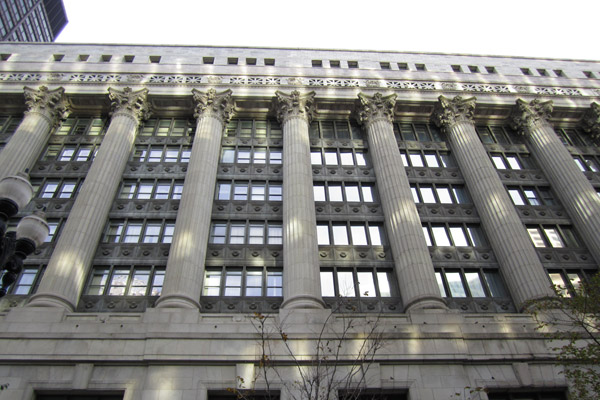
The Sun-Times has a piece about the mayor's plan to renovate City Hall and consolidate city offices into the building at a cost of $12 million, with projected future savings to come. It's worth reading, as it's the general principle behind the Infrastructure Trust (though not part of it): spend money now to modernize city facilities in order to save money over the long term, so it bears watching—whether it comes in on time and on budget, whether the savings add up in the end.
And it's a perfectly fine piece, until the infuriating last line:
City Hall was built in 1911 at $5 million — less than half the cost of Emanuel’s renovation.
It's an even worse deal when you consider that the entire Louisiana Territory cost only $15 million, just $3 million more than the City Hall renovation.
Anyway, if you guessed that we were unable to get the legendary firm of Holabird and Roche to work that cheap, you're right. City Hall cost $5 million in 1911, which is about $120 million today. It was the city's seventh City Hall in eighty years—the first was in the Saloon Building, because, of course—and followed a series of architectural and physical disasters, including but not limited to the Great Fire. This might sound familiar (PDF):
In August 1875, ground-breaking ceremonies were held and construction begun on the new city hall and county buildings designed by Egan in a colonnaded French Renaissance style as a dual structure for joint occupancy by city and county. With the money to go ahead, the county began construction first. After numerous delays and a lengthy construction period, the county building was completed in 1882, with completion of the city hall in 1885. The costs for both the county courthouse and city hall came to more than $4 million.
They didn't get much for the money:
As soon as the building was finished, its limitations became evident. The interior with its high ceilings, small windows, oddly sized rooms, and long, drafty, dark corridors made for inconvenience and discomfort. Secondly, because the building had been under construction for so long, it was already overcrowded before it was finished, and some employees had to be moved into rented space. The inadequacies of the recently opened buildings made it evident that consideration must be given to the need for a new city hall and a new county building.
The city didn't actually have the money to replace it, though, since they'd just blown about $100 million in current dollars on the mess. Fortunately or something, in 1905 the building sank six inches, causing a gas pipe to rupture, which created an explosion that blew the roof off the building. That gave the city an excuse to build a proper city hall, and the county moved in to its half of the building by 1907.
So why was City Hall only completed in 1911? The city had to wait two years for the state to raise its debt limit. Now, hopefully, the unbroken chain of economic history makes a bit more sense.
Photograph: danxoneill (CC by 2.0)


